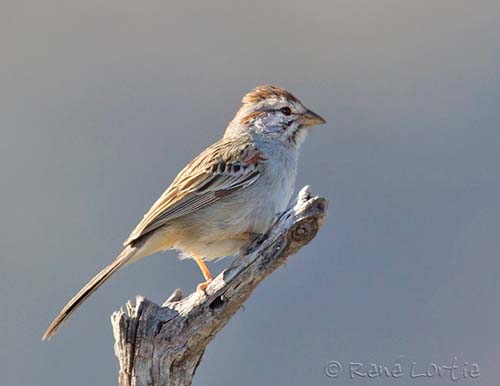
Fr: Bruant à épaulettes
All : Rostflügelammer
Esp: Chingolo Sonarense
Esp (Mexique): Zacatonero ala rufa, Zacatonero Alirrujo, Zacatonero sonorense
Ital: Passero alicastane
Nd: Roestvleugelgors
Sd: Rostvingad sparv
Photographers:
Tom Grey
Tom Grey's Bird Pictures
René Lortie
http://rlortie.ca/
Text by Nicole Bouglouan
Sources:
HANDBOOK OF THE BIRDS OF THE WORLD Vol 16 by Josep del Hoyo- Andrew Elliot-David Christie – Lynx Edicions – ISBN: 9788496553781
FIELD GUIDE TO THE BIRDS OF NORTH AMERICA - National Geographic Society - ISBN: 0792274512
BirdLife International (BirdLife International)
All About Birds (Cornell Lab of Ornithology)
What Bird-The ultimate Bird Guide (Mitchell Waite)
Rufous-winged Sparrow
Peucaea carpalis
Passeriforme Order – Passerellidae Family
BIOMETRICS:
Length: 13-14 cm
Wingspan: 21 cm
Weight: 13-17 gr
DESCRIPTION:
The Rufous-winged Sparrow (here displayed) is a shy species, always difficult to see. But when the male starts to sing from exposed perch, the bird is worth seeing.
The adult male of nominate race has buffy-grey upperparts, mantle and scapulars, with dark streaks edged rufous. The rump is paler.
The upperwing is dark brown with rufous lesser coverts forming a rusty patch, whereas median and greater coverts are edged buffy and have buffy-white tips. This pattern forms two indistinct wingbars. The flight feathers are edged greyish-buff.
On the uppertail, rectrices are dark grey-brown with paler edges. The tail is fairly long and rounded.
On the underparts, the throat is whitish, whereas neck sides and rest of underparts are pale grey with paler belly and washed buff flanks.

On the head, crown and nape are rufous with grey median stripe. We can see a broad grey supercilium. Head sides are grey too, with rufous postocular stripe. Lores are black. The short, narrow, blackish moustachial and malar stripes are separated by pale grey submoustachial area.
The bill is pale horn to pinkish-flesh, with dark ridge on upper mandible. The eyes are brown. Legs and feet are pale brownish.

Male and female are similar.
The juvenile resembles adult with buffer plumage overall and dark brown areas, not rufous. Breast and flanks are heavily streaked dark brown.
We can find 3 subspecies which differ in size and plumage tones:
P.c. carpalis (here described) is found in extreme S USA (SC Arizona) and adjacent NW Mexico (S to C Sonora). This is the largest race and the greyest above.
P.c. bangsi occurs in NW Mexico, NC Sonora S to N Sinaloa. This one is slightly browner above than nominate. It has intermediate size.
P.c. cohaerens is found in N and C Sinaloa. This race is the smallest and darkest, with rufous tinge on rump and back.
VOICE: SOUNDS BY XENO-CANTO
The Rufous-winged Sparrow’s call is a sharp, high-pitched “seep”, and we can also hear “chink” notes.
The song is variable, a plaintive series of “chip” notes, followed by an accelerating trill “chip burr chip-ip-ip-ip-ip-ip-ip”. It also utters a “chip chip whecoo”.

HABITAT:
The Rufous-winged Sparrow breeds in flat desert scrub scattered with thorn-scrub with mixed bunchgrass, and also in open farmland in deciduous forest such as mesquite (Proposis), hackberry (Celtis) and acacia (Acacia) with cholla cactus (Opuntia).
This species is visible from sea-level up to 1200 metres of elevation.
RANGE:
See above in “subspecies”
BEHAVIOUR:
The Rufous-winged Sparrow feeds on seeds and insects. During winter, it takes mainly seeds from several grass species. But during summer, it feeds primarily on inchworms (Geometridae) and other caterpillars. It may take some spiders too.
It forages mainly near or on the ground and low in vegetation, by hopping. It may occasionally hawk insects from the ground by short flight in mid-air. This species is often seen in pairs or small groups.

The Rufous-winged Sparrow is monogamous and pair-bonds may last throughout the year.
The male is territorial and stays close to the female during the laying period to guard her. The nesting duties such as nest-building and incubation are performed by female. However, both adults feed the chicks, and when the female starts a second brood, the male feeds the juveniles once they fledge.

Courtship displays are not described, but the male probably performs some aerial displays.
The species is resident in its range, and pairs remain on territories all year round. Some movements may occur to find food sources. The young perform post-breeding dispersal within 100 kilometres from usual breeding sites.
FLIGHT:
The Rufous-winged Sparrow has direct or slightly undulating flight over long distances.

REPRODUCTION:
The breeding season takes place usually during summer, from June to early October, depending on rains. But in wet years, this species may also nest in spring.
The female builds the nest in low shrub or cactus, in spiny tree or mesquite, between 15 cm and 2 metres above the ground. This is a large, deep cup made with grasses, dry weeds and small twigs. The inner cup is lined with animal hair.

The female lays 2-4 whitish to pale greenish, unspotted eggs. She incubates during 11 days. The chicks are fed by both parents and fledge 8-9 days after hatching.
This species produces one or two broods per year, according to the rains. The nest is sometimes parasitized by the Brown-headed Cowbird.
DIET:
The Rufous-winged Sparrow feeds mostly on insects and seeds. The summer diet includes caterpillars and grasshoppers, other insect’s species and spiders. Outside this period, it takes mainly seeds from grasses and weeds.
It forages mainly on the ground, usually in pairs or family groups, and sometimes associated with Black-throated Sparrows.

PROTECTION / THREATS / STATUS:
The Rufous-winged Sparrow is classified as “rare” in the USA. The species can be common in suitable habitat.
This species is threatened by degradation of its habitat by overgrazing and human developments. In some parts of the range, and especially in North, numbers vary according to rainfalls.
However, the species is not currently threatened and evaluated as Least Concern by BirdLife International.
